Art & Craft
Mata ni Pachedi
The original creators of Mata ni Pacchedi were the Devi Pujak who lived along the edges of the Sabarmati River in Gujarat. Translating to ‘behind the Mother Goddess”, these textiles are sacred, wall art pieces used as a backdrop for shrines. The original style only involved using two colors – black and red, made out of natural dyes. The illustrations on the cloth consist of a central deity surrounded by designs depicting nature, light, animals, and artistic creations all worshipping the Goddess The designs are made using hand block prints and freehand painting.
Mata Ni Pachedi is a traditional art form of Gujarat, India, which is a revered art form and religious tradition that originated among the nomadic Vaghari community. The term “Mata Ni Pachedi” literally means “behind the mother goddess” in Gujarati. This art form is a cloth that constitutes a temple of the goddess, featuring the Mother Goddess at the center and her stories.
History and Significance
The history of Mata Ni Pachedi dates back to 500 years, when the nomadic Vaghari community of Gujarat, who worship Mata, were not allowed to enter temples. They created their own places of worship with illustrations of the Mother Goddess on pieces of cloth, which is believed to be the origin of Mata Ni Pachedi. This art form is a unique expression of devotion to the divine mother goddess, particularly Mataji, or Amba Mata.
Artistic Style and Techniques
Mata Ni Pachedi is a traditional textile art form that is practiced by the Vaghari community. The art form is created using a pen (kalam) made out of bamboo, and the painting is done using natural colors. The design typically features the Mother Goddess at the center, flanked by other elements of her story, including devotees, flora, and fauna.
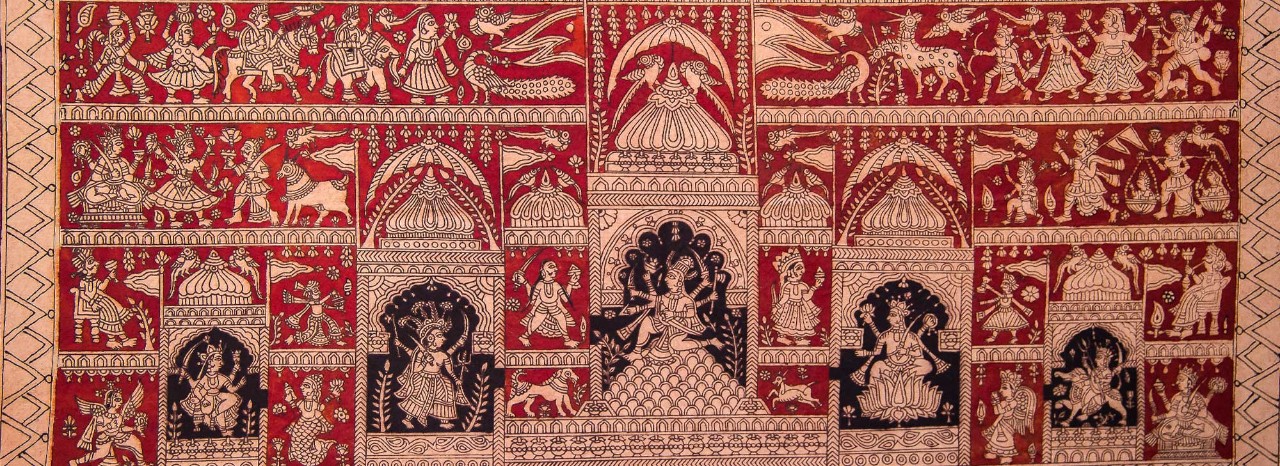
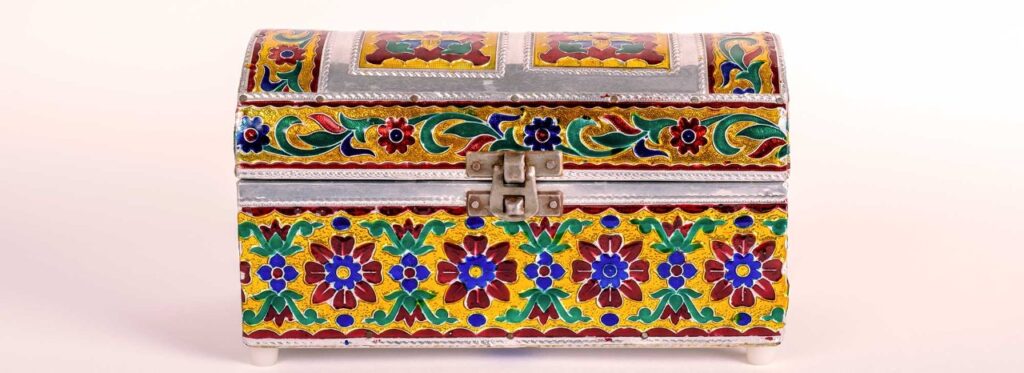
White metal/meenakari
The history of metal craft in Gujarat dates way back to the Indus Valley Civilization. Gujarati craftsmen are experts at working magic with metal to create beautiful metal pieces – these include sculptures, utensils, vases, ornaments, boxes. Each one stands out because of its expert craftsmanship, finesse and finishing. The metals used include iron, copper and silver as well as alloys like bell metal, white metal and bronze. The surface of these metals, once crafted into their desired shape, are coloured and decorated using brilliant colours and intricate designs that give rise to the ‘meenakari’ form of art.
White metal, also known as Meenakari, is a traditional craft in Gujarat, India. It involves crafting beautiful metal pieces using various metals and alloys, such as iron, copper, silver, and bronze. The process involves shaping the metal into desired forms, coloring, and decorating it with intricate designs.
History of Meenakari in Gujarat
The history of metal craft in Gujarat dates back to the Indus Valley Civilization. Over time, Gujarati craftsmen have perfected their skills, creating exquisite pieces that showcase their expertise in craftsmanship, finesse, and finishing.
Types of Meenakari Pieces
Gujarati craftsmen create a wide range of Meenakari pieces, including:
- Scultures: Intricately designed metal sculptures that showcase the craftsmanship of the artisans.
- Utensils: Beautifully crafted metal utensils, such as vases, boxes, and ornaments.
- Vases: Decorative metal vases that add a touch of elegance to any room.
- Ornaments: Exquisite metal ornaments that make for beautiful jewelry or decorative pieces.
- Boxes: Intricately designed metal boxes that can be used for storing small items or as decorative pieces.
Characteristics of Meenakari
Meenakari pieces are known for their:
- Expert craftsmanship: Each piece is crafted with precision and attention to detail.
- Finesse: The intricate designs and patterns add a touch of elegance to each piece.
- Finishing: The metal pieces are polished to perfection, giving them a beautiful sheen.
Sadeli
Sadeli is said to have come to Gujarat through the Parsis from Iran. The craft bears close similarities to the Persian form of marquetry called ‘Khatam’. Sadeli is a highly skilled technique where the craftsmen, in this case carpenters, fabricate intricate geometric or floral patterns on teak or other locally available wood. The elaborate designs add a charming aesthetic to doors, windows, cupboards, and bedposts. In fact, the famous Bombay Box–a tourist favourite–is actually a Sadeli handicraft from Gujarat. More recently, the craft of Sadeli is used to make sofa sets, book racks and lamp holders.
Sadeli is a highly skilled wood craft native to Surat, Gujarat. It involves precisely cutting geometric patterns on wooden articles to produce aesthetically appealing designs. The craft is said to have come to Gujarat through the Parsis from Iran and bears close similarities to the Persian form of marquetry called ‘Khatam’.
Traditional Use
Traditionally, Sadeli was used to decorate doors, windows, and furniture. However, with its increasing popularity, it is now being used on boxes, frames, and other decorative items.
Modern Applications
Sadeli is used in exclusive and marvelous decorative pieces, such as sofa sets, book racks, and lamp holders. The intricate craft is also used to make multipurpose boxes, like the one described in the Amazon product description, which can be used to store valuables like personal jewelry or family heirlooms.
Gujarat’s Handicrafts
Gujarat is known for its rich handicrafts, including Sadeli. The state has a long history of promoting handicrafts, and the Prime Minister of India, Narendra Modi, has been instrumental in promoting and gifting Gujarat’s handicrafts to global leaders.
Gujarat’s Handloom & Handicrafts Development Corporation
The Gujarat State Handloom & Handicrafts Development Corporation Ltd (GSHHDC) was established in 1973 to identify, revive, and develop handicrafts and handlooms of Gujarat. The corporation works closely with weavers and artisans to promote and preserve traditional crafts like Sadeli.
Interesting Facts
- Sadeli is a highly skilled technique that requires great precision and craftsmanship.
- The craft is used to make intricate geometric or floral patterns on teak or other locally available wood.
- The famous Bombay Box, a tourist favorite, is actually a Sadeli handicraft from Gujarat.
- Sadeli is often used to make decorative pieces like lamp holders, book racks, and sofa sets.
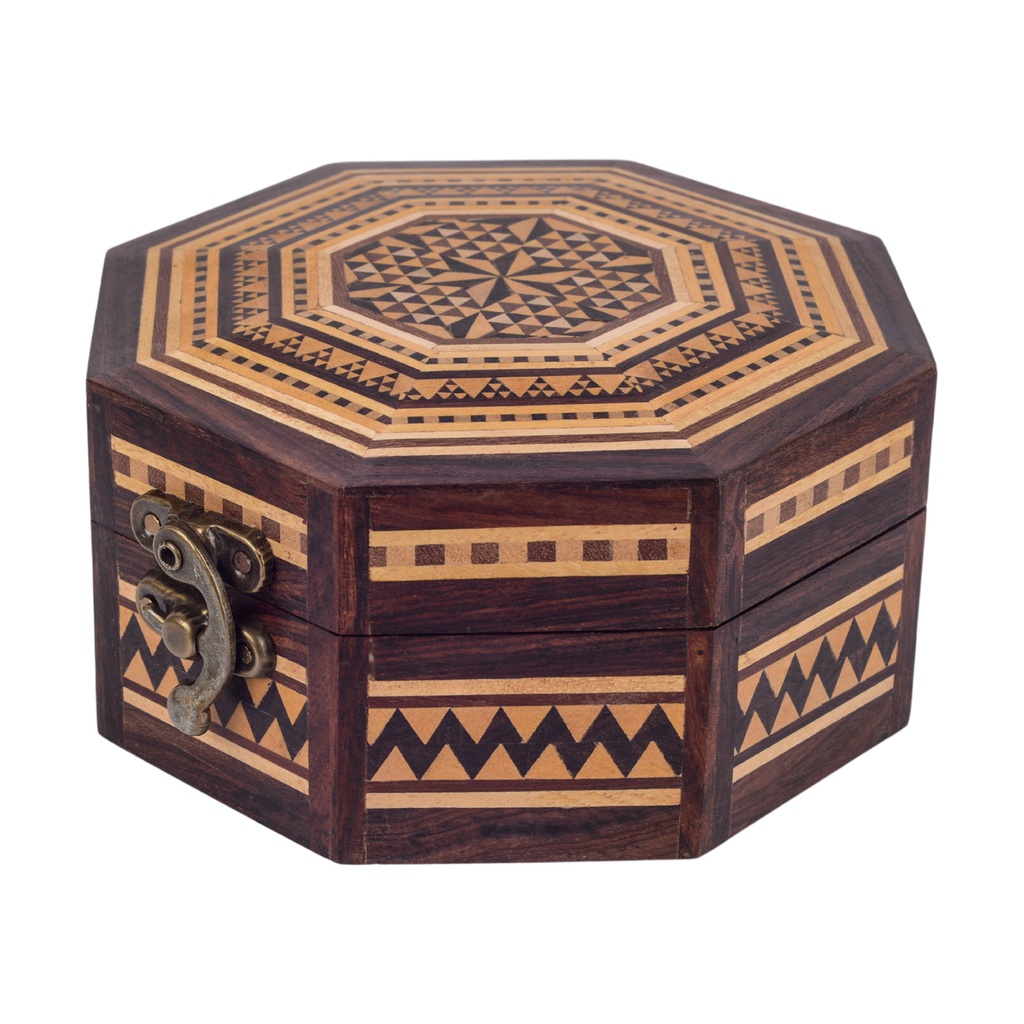
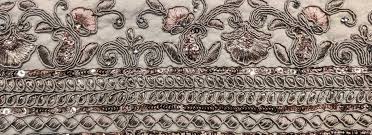
Zardosi
One of the finest techniques of embroidery is the Zardosi style, which is often used to add a royal touch to fabric. Zardosi is an art that uses metallic coated thread to make beautiful, intricate designs on cloth. The thread is usually made of thin strands of gold, silver or copper. To make these elaborate designs, the thread is held with a finger at the reverse of the fabric and the aari, a needle with a sharp point, is held on the top. Craftsmen use materials like sequins, beads, pearls, precious and semi-precious stones to sew on the fabric in elaborate patterns. Today, this exquisite style of embroidery is popularly used in bridal trousseaus.
Zardosi is a traditional handicraft that originated in Gujarat, India. It is a unique embroidery technique that uses metallic coated thread to create intricate designs on fabric. The thread is usually made of thin strands of gold, silver, or copper.
History of Zardosi in Gujarat
Zardosi has a rich history in Gujarat, dating back to the time of the Rig Veda. It is believed to have been introduced to the region by the Mughals, who brought with them their own embroidery techniques.
Traditional Zardosi Craftsmen
In Gujarat, Zardosi is typically practiced by skilled craftsmen who have learned the technique from their ancestors. These craftsmen use a needle with a sharp point, known as an aari, to stitch the metallic thread onto the fabric. The thread is held with a finger at the reverse of the fabric, and the aari is held on top.
Materials Used
Zardosi craftsmen use a variety of materials to add a royal touch to their embroidery. These include sequins, gota, beads, nakshi, dabka, or shiny stones. The shimmering springs of thin gold, silver, or copper stitched onto the fabric create a beautiful and intricate design.
Zardosi in Modern Times
Today, Zardosi is still practiced in Gujarat, and many craftsmen continue to pass on their skills to the next generation. The craft is highly valued for its beauty and intricacy, and is often used to create traditional clothing and textiles.
Gujarat State Handloom & Handicrafts Development Corporation Ltd.
The Gujarat State Handloom & Handicrafts Development Corporation Ltd. (GSHHDC) is a government undertaking that markets the state’s handloom and handicraft products, including Zardosi. The corporation was established in 1973 with the main objective of identifying, reviving, and developing the state’s handicrafts and handlooms.
Warli Painting
The beauty of warli paintings is that each one tells a unique story. In Gujarat, it’s a style commonly practised by the artisans of the Dang district. It uses a combination of simple shapes, that each bear a symbolic meaning. Traditionally used as a wall decoration, many of the tribal huts in the villages of South Gujarat have these paintings on their walls. If you look closely at each one, you’ll notice that every symbol of Warli art carries a strong message. For example, central motifs symbolize the mother goddess. Squares represent fertility and prosperity and triangles symbolize mountains and trees.
Warli painting is a traditional art form practiced by the artisans of the Dang district in Gujarat, India. It is a form of tribal painting that uses simple shapes, such as lines, circles, triangles, and squares, to create motifs and forms. The paintings are traditionally used as a wall decoration in tribal huts in the villages of South Gujarat.
Characteristics of Warli Painting in Gujarat
- The paintings are typically white in color, made from a mixture of rice paste and water, and are applied to a red ochre background.
- The Warli artisans use a combination of simple shapes to create intricate designs and patterns.
- Each painting tells a unique story and carries a strong symbolic meaning.
- The central motif in each painting is often the mother goddess, symbolizing fertility and abundance.
- Other common symbols in Warli paintings include the sun, moon, and animals, which are often depicted in geometric shapes.
Significance of Warli Painting in Gujarat
- Warli painting is an important part of the cultural heritage of Gujarat and is considered a symbol of the state’s rich artistic tradition.
- The paintings are not only a form of artistic expression but also play a significant role in the daily lives of the Warli community, who use them to tell stories, convey messages, and celebrate special occasions.
- Warli painting has gained popularity in recent years, with many artists and designers incorporating the style into their work.
Where to Find Warli Painting in Gujarat
- The Dang district in Gujarat is the hub of Warli painting, with many artisans and artists based in the region.
- You can find Warli paintings in many of the tribal huts and villages in South Gujarat, where they are used as a form of decoration and storytelling.
- Many art galleries and museums in Gujarat also feature Warli paintings, offering a glimpse into the state’s rich cultural heritage.
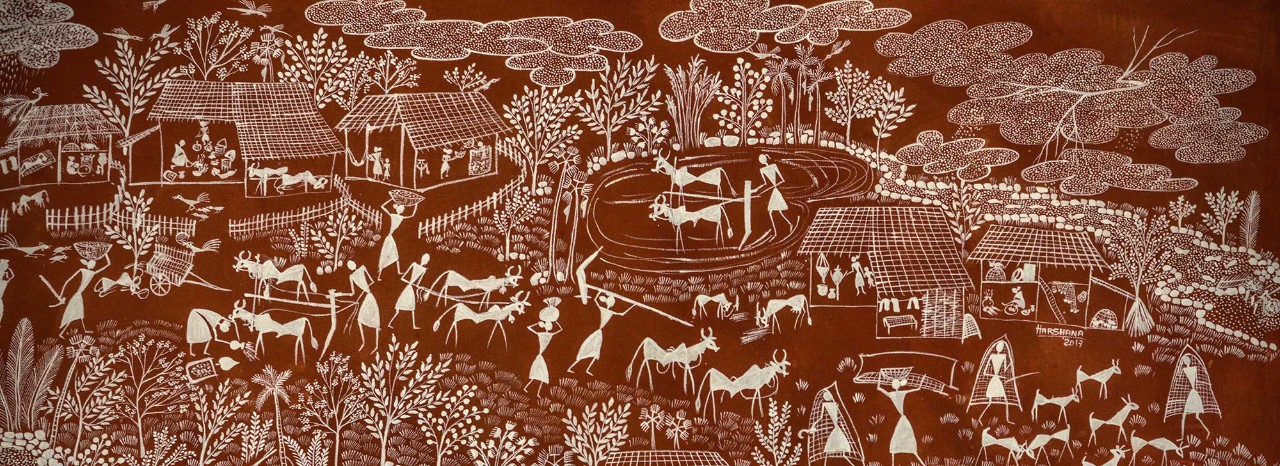
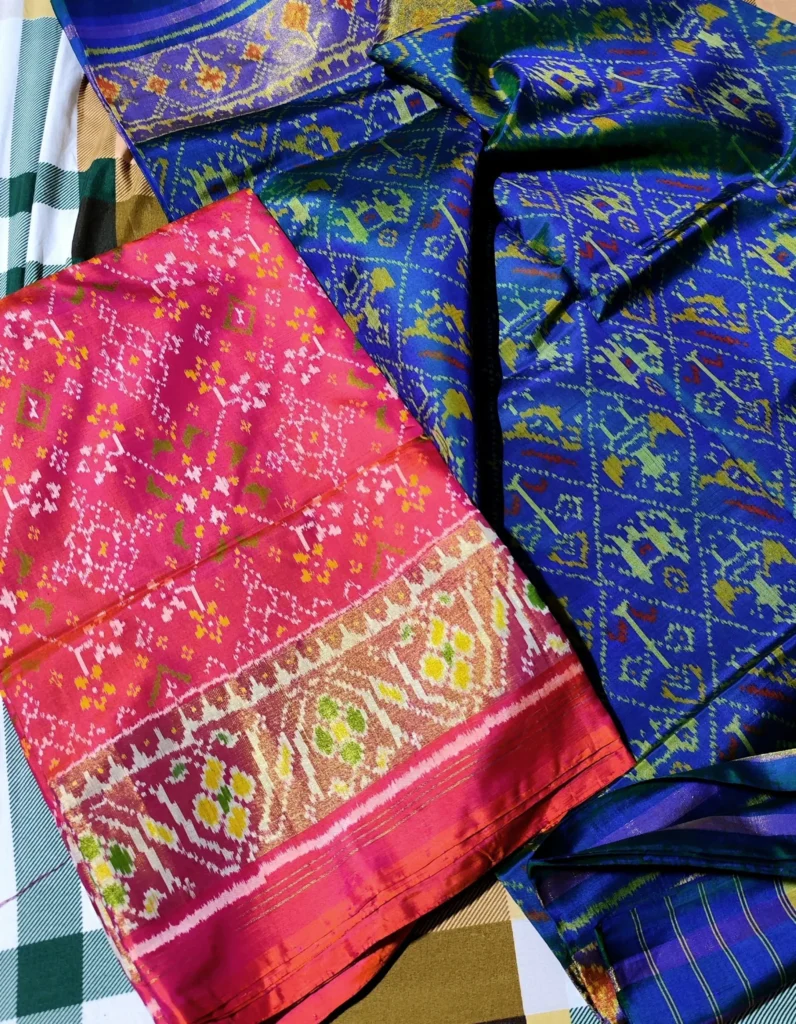
Ajrakh
Hand block painting or Ajrakh is an age-old tradition practiced in Ajrakhpur, a village in the Kutch district of Gujarat. The 100-odd families of the village take part in a laborious process that takes up to three weeks to complete. Textiles are treated with vegetable and mineral colours and the fabric goes through a washing cycle about eight times. But the end result is a beautiful piece of fabric that has also made its way to high-end fashion labels today. This fine art includes a detailed process of resist-printing and dyeing using about 20 blocks. Today, it is used extensively on turbans, shawls and bedsheets.
Ajrakh is an ancient block printing technique that originated in Sindh and is believed to have been in existence from as far back as 3000 BC. The craft was mastered by the civilizations that flourished around the Indus River in Sindh area. In Gujarat, Ajrakh printing is a traditional craft practiced in the village of Ajrakhpur, which is located in the Kutch district.
Process of Ajrakh Printing
The process of Ajrakh printing is laborious and time-consuming, taking up to three weeks to complete. Textiles are treated with vegetable and mineral colors, and the fabric goes through a washing cycle about eight times. The block printing is done using natural dyes and designs, with no machinery or automation involved.
Inspirations and Materials
The block printing of Ajrakh takes inspiration from natural colors and is hand-crafted with no machinery or automation involved whatsoever. The practice of Ajrakh printing evolved from the Indus Valley Civilisation thousands of years ago and is still preserved and practised in the small village of Ajrakhpur.
Location and How to Reach
Ajrakhpur is located at a distance of 15 kilometres from the city of Bhuj, Gujarat. The village can be reached by train or air. By train, it is 14.4 KM away from Bhuj Railway Station, and by air, it is 16.8 KM away from Bhuj Airport.
Preservation and Revival
The traditional craft of Ajrakh dwindled drastically till steps were taken to revive it in the 1960s by key figures like Kamaladevi Chattopadhyay. The Gujarat State Handicraft Development Corporation and its retail wing Gurjari were established in the early 1970s to save the crafts that were in jeopardy.
Bandhani
This is a popular tie and dye technique that involves twisting, tying and dyeing to produce some gorgeous patterns. Bandhani generally uses natural colours, predominantly yellow, blue, green and black. Each colour has its own significance. For example, red is a symbol of good fortune to a bride and yellow is a sign of spring time and joy. The designs on the fabric are formed by a combination of dots that are first block printed on the fabric. Some popular designs are the sikharibhat (jungle scene), ambaa dal (mango orchard) and chakalipopat (sparrow, parrot).
Bandhani is a traditional tie-dye technique that originated in Gujarat, India. It is a resist dyeing process where the fabric is pinched and tied with thread before it is dyed to create a pattern made up of small dots. This ancient craft has been practiced in Gujarat for centuries, and the state is home to many skilled artisans who have mastered the technique.
History of Bandhani in Gujarat
The earliest evidence of Bandhani dates back to the Indus Valley Civilization, where dyeing was done as early as 4000 B.C. The craft was later introduced to Gujarat by the Khatri community, who are renowned for their expertise in Bandhani. Over time, the technique spread to other parts of the state, including Rajasthan, Sindh, and Tamil Nadu.
Types of Bandhani in Gujarat
There are several types of Bandhani in Gujarat, each with its unique characteristics and designs. Some of the most popular types include:
- Kutchi Bandhani: This type of Bandhani is known for its extremely fine dots and sophisticated sense of composition. It is traditionally practiced by the Khatri community in Kutch.
- Saurashtrian Bandhani: This type of Bandhani is known for its bold patterns and bright colors. It is practiced in the Saurashtra region of Gujarat.
- Rajasthani Bandhani: This type of Bandhani is known for its intricate designs and patterns. It is practiced in the Rajasthan region of Gujarat.
Designs and Patterns
Bandhani fabrics are known for their intricate designs and patterns, which are created by tying knots on the fabric before it is dyed. The designs can range from simple dots to complex patterns, and are often inspired by nature, mythology, and everyday life.
Colors and Dyes
Bandhani fabrics are typically dyed using natural colors, including yellow, blue, green, and black. Each color has its own significance, and is often used to represent different emotions and meanings.
Significance of Bandhani in Gujarat
Bandhani is an important part of Gujarat’s cultural heritage, and is often used to create traditional clothing, such as sarees, suits, and turbans. It is also used to create decorative items, such as bags, scarves, and home furnishings.
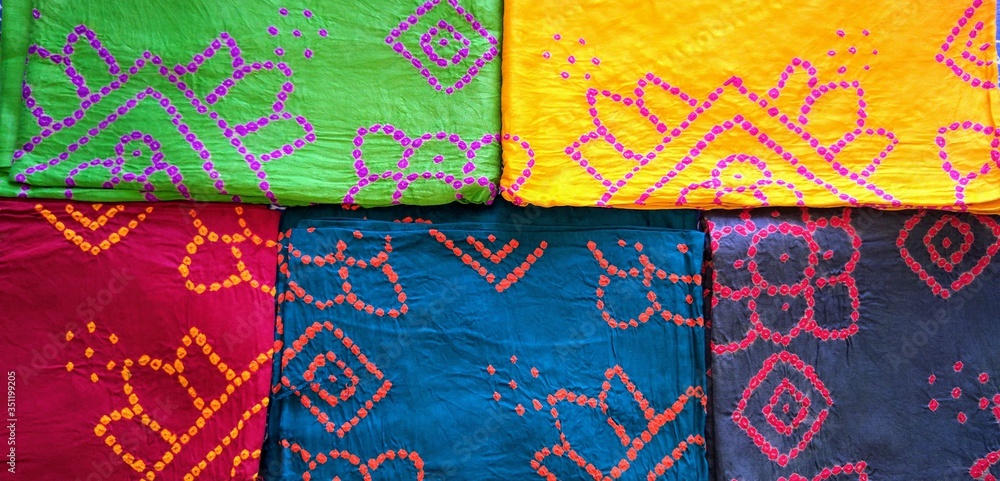

Metal Work
Gujarat is no stranger to the labour of hammering, forging and casting that goes into producing pieces of metal. The state has been home to metal work for hundreds of years and today, you’ll find these stunning pieces in different corners of the world. These include statues, vases, utensils, ornaments, jewellery and furniture that boast of ornate designs. The Kutch specialty is silver jewellery renowned for its intricate handiwork. Besides silver, craftsmen use iron, copper and brass to cast some exquisite artefacts. The metal work reflects the finesse of artists who have spent years perfecting the craft.
Gujarat is a hub for metal work in India, with a wide range of industries and manufacturers operating in the state. Here are some key details about metal work in Gujarat:
- Metal Bushes Manufacturer: Rajmetal Industries, based in Ahmedabad, Gujarat, is a prominent manufacturer and supplier of metal casting, gun metal casting, bronze casting, and other metal products.
- Sheet Metal Fabrication: There are several sheet metal fabrication providers in Ahmedabad, Gujarat, offering services such as sheet metal fabrication, laser cutting, stamping, and machining. Some notable companies include Gopal Eng. Works, Daskroi, Ahmedabad, and Metal Craft of Gujarat.
Key Locations for Metal Work in Gujarat
- Ahmedabad: Ahmedabad is a major hub for metal work in Gujarat, with several manufacturers and suppliers operating in the city.
- Kathawada: Kathawada is another important location for metal work in Gujarat, with several sheet metal fabrication providers and metal casting manufacturers operating in the area.
Notable Companies
- Rajmetal Industries: A prominent manufacturer and supplier of metal casting, gun metal casting, bronze casting, and other metal products.
- Gopal Eng. Works: A sheet metal fabrication provider offering services such as sheet metal fabrication, laser cutting, stamping, and machining.
- Metal Craft of Gujarat: A company known for its excellence in creating metal wares with a distinct style and wide variations.
Copper Bells
Bells are hand cast in a variety of shapes and sizes displayed singularly or in a group to perform musical functions. The sound of each bell is set with an instrument called ekal. The tonal quality and the resonating sound are dependent on three factors inherent to the making. The shape and size of the bell, along with the wooden thong sourced from the local Khirad tree determines the sound it imparts.
The structure and curvature of the bottom which is delicately beaten into shape using a harmonic hammer resonates the sound deepening its after glow.
Bells chimed their way into Kutch from Sindh centuries ago, tied to the necks of migrating cattle.
Copper bells are a traditional craft in Gujarat, India, with a rich history dating back centuries. The craft has been passed down through generations, with artisans in the region creating beautiful and unique copper bells.
Handcrafted Jhumar Copper Bell
One type of copper bell is the Handcrafted Jhumar Copper Bell, made by artisans in Gujarat. This bell features intricate designs and patterns, with a striking jhumar attached to the bottom. It is a unique and eye-catching piece that can add elegance and tradition to any home.
Gujarat Copper Alloys Limited
Gujarat Copper Alloys Limited is a company based in Gujarat that specializes in copper alloys. The company has a rich history, with its directors including Ravi Mohanlal Jain, Rameshchandra Bagatawarmal Jain, Avi Mohanlal Jain, Sumit Ramesh Jain, and Kanika Ravi Jain.
Copper Bell Making Process
The process of making copper bells involves several steps. The bells are hand cast in a variety of shapes and sizes, and the sound of each bell is set with an instrument called ekal\xad. The tonal quality and resonating sound are dependent on three factors: the shape and size of the bell, the wooden thong sourced from the local Khirad tree, and the way the bell is made.
Copper Bell in Kutch
Bells have been a part of Kutchi culture for centuries, with the first bells being brought to the region from Sindh centuries ago. The bells were tied to the necks of migrating cattle, and over time, the craft of making copper bells developed in the region.
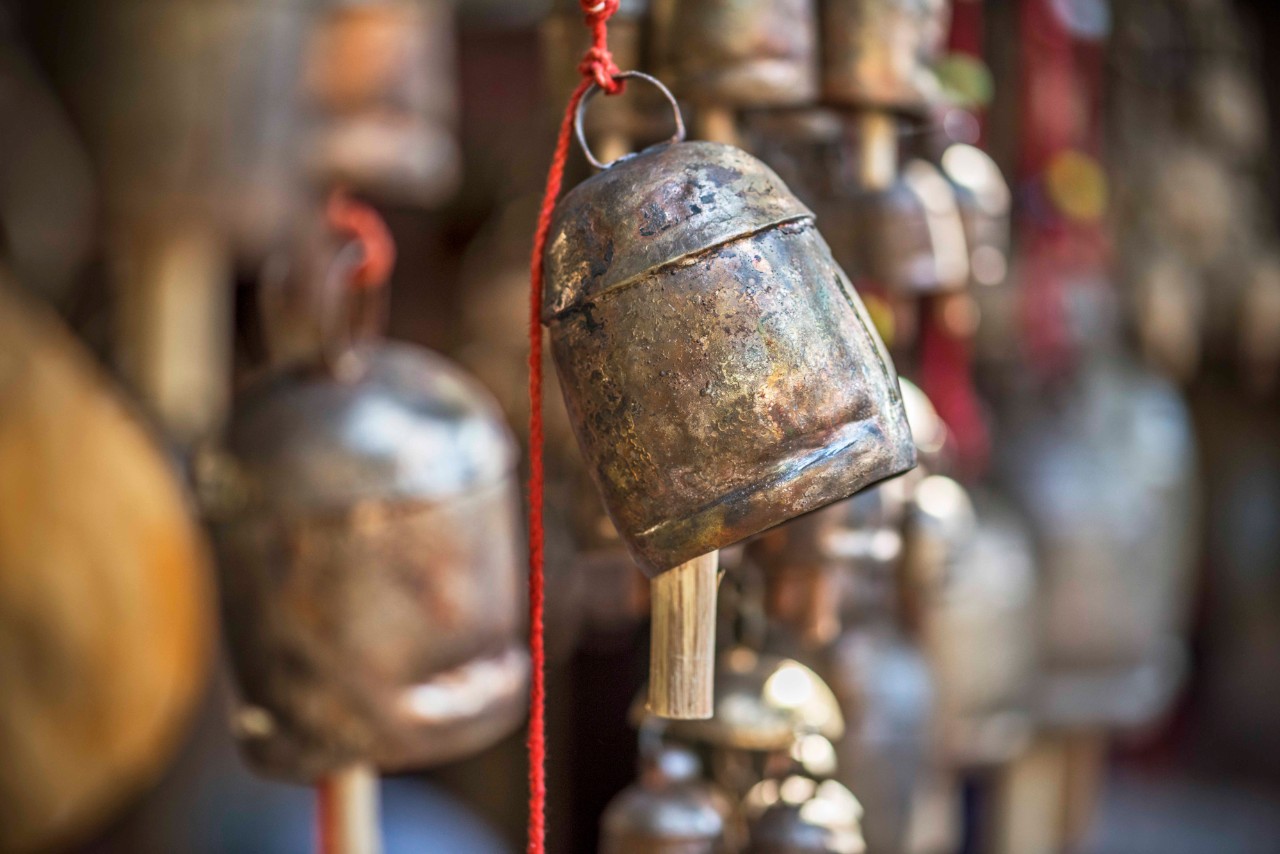
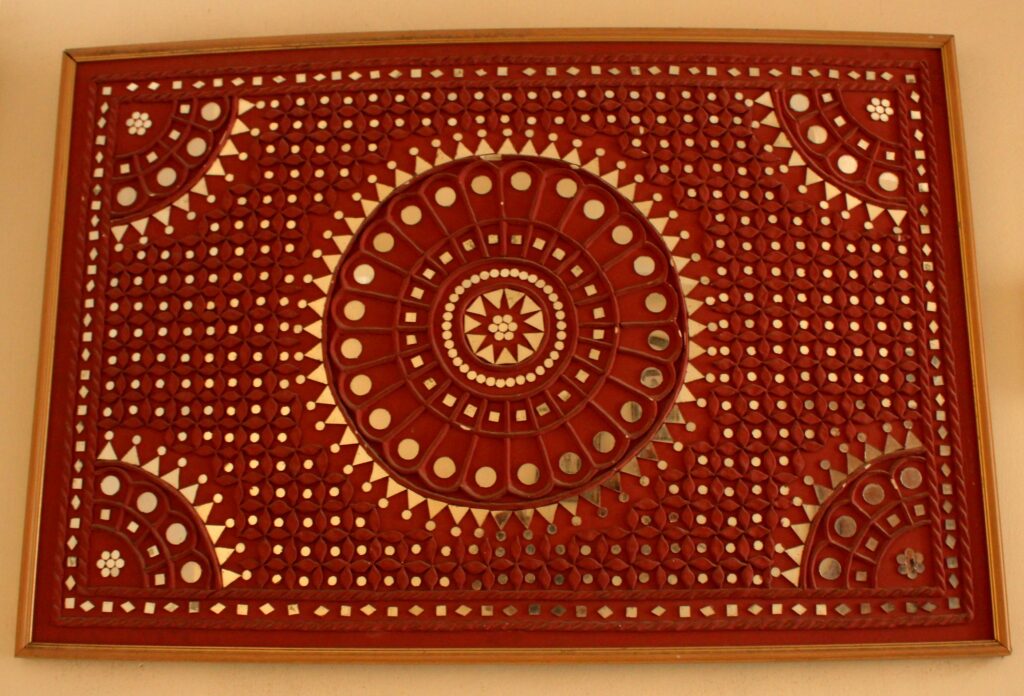
Mud Work
The craft of mud work is deeply ingrained in Gujarat’s history and its popularity has spread across the world over the years. Inspired by clay art, this is a tradition that goes back years amongst the Kutch craftsmen. Mud work frames from Kutch are wonderful representations of the culture and history of the state. Through little details like depicting local flora and fauna, the art form brings to life the authentic culture and traditions of Gujarat. Today, artisans make attractive wall pieces with some beautiful mirror work and traditional clay utensils like pots, plates, bowls that are hand painted.
Mud work, also known as Lippan Kaam, is a traditional mural craft of Kutch, Gujarat, India. This craft is deeply ingrained in Gujarat’s history and has spread across the world over the years. Inspired by clay art, mud work frames from Kutch are wonderful representations of the culture and history of the state.
Craftsmanship and Techniques
Artisans in Kutch use a mixture of clay and camel dung to create the mud work, which is then applied to wooden frames. The mixture is applied in intricate designs, often depicting local flora and fauna, and is then coated with washable colors. The art form brings to life the authentic culture and traditions of Gujarat.
Types of Mud Work
Mud work frames from Kutch are available in various forms, including:
- Wall pieces: Attractive wall pieces with beautiful mirror work and traditional clay utensils like pots, plates, and bowls that are hand-painted.
- Mirror frames: Handmade mirror frames with intricate designs and patterns, often featuring local flora and fauna.
- Traditional clay utensils: Hand-painted clay utensils like pots, plates, and bowls that are a part of the traditional craft.
Workshop and Training
Mud Mirror Workshop by Kutchi Artist offers hands-on exercises on 12 by 12 inches square mirror frames under the guidance of a Kutchi Artist. This workshop provides an opportunity to learn the traditional craft of mud work and mirror work.
Benefits and Features
Mud work from Kutch is known for its:
- Longevity: The art form is durable and long-lasting.
- Durability: The mud work is resistant to wear and tear.
- Artistic touch: The intricate designs and patterns add an artistic touch to the craft.
- Washable colors: The colors used in the art form are washable, making it easy to maintain.
Soof Embroidery
Gathiya is a tea-time snack. It is primarily made of besan or gram flour. It is like a thicker sev, however, there are a few notable differences. There are usually two kinds of Gathiya: Tikha (spicy) Gathiya and regular Gathiya. The difference is in terms of the spices used in the dough. The regular one has carom seeds, salt, turmeric, soda bicarb, and a dash of oil. Tikha has additional spices like black pepper and red chilli powder. The dough is then made to pass through a mould, making its strands, straight into the oil for deep frying. The end result is not crunchy, but a bit soft. Must try, for sure!
Soof Embroidery is a traditional handicraft of Gujarat, India, practiced by the Sodha community. It is a unique style of embroidery that is characterized by intricate geometric motifs created using small triangles. The artisans visualize the design and create it on the fabric by counting the warp and weft yarns.
Key Features
- Geometric motifs created using small triangles
- Satin stitch directly on the fabric without drawing
- Precise counting of threads in warp and weft
- Vibrant colors used to create the design
- Mirror work is often used to add an extra layer of appeal
- Traditionally used on shawls and veils, but now used on various fabrics and garments
Influences
- The mochi embroidery style with “chin stitch and parrot circle” patterns has influenced the Soof Embroidery style
- The Kutch Embroidery style, which is also practiced in Gujarat, has similarities with Soof Embroidery
Artisans
- Traditionally practiced by women of the Sodha community
- Approximately 6,000 women are engaged in this craft
- Many societies and private corporations are involved in the production of Soof Embroidery
Materials
- Fabrics made of threads of cotton, silk, woolen, and mashru (an Arabic name)
- Satin stitch and mirror work are used to create the design
Significance
- Soof Embroidery is a unique and traditional handicraft of Gujarat
- It is a significant part of the state’s cultural heritage
- It provides employment opportunities for thousands of women in the state
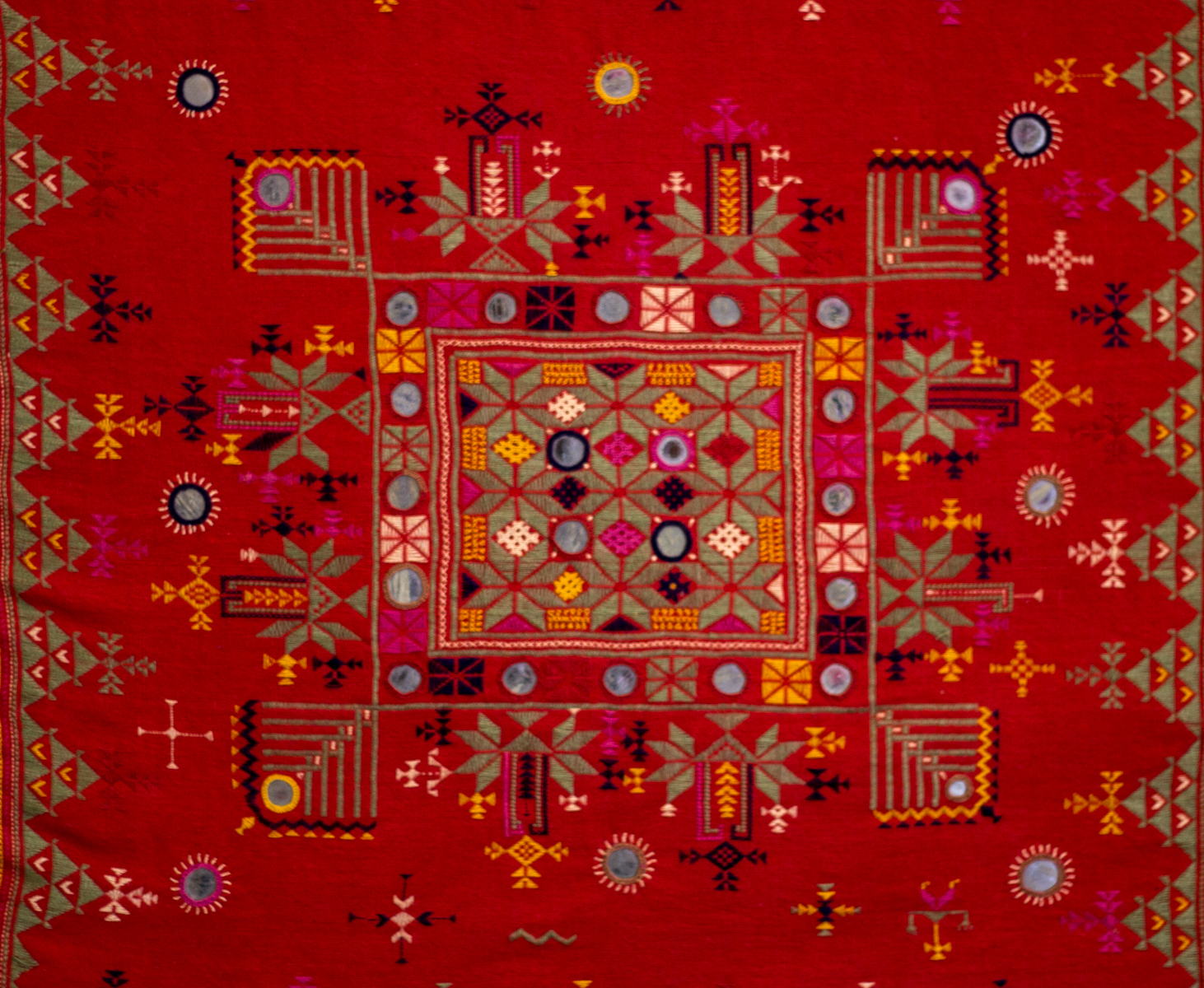

Leather Work
The indigenous community of Meghwals are prime producers of leather work in the Kutch district of Gujarat. This is one of those timeless crafts which has grown to combine traditional methods of design with modern functionalities. Its production is a combined effort between men and women. The men fashion the product from the leather while the women embellish it with mirrors and bead work. Originally, the craft was used to make saddles for elephants and horses, sword sheaths and accessories for war. Today, it is used to make beautiful bags and shoes with colourful tassels and embellishments.
Gujarat is a significant hub for leather work in India, with numerous companies and manufacturers based in the state. Here are some key details about leather work in Gujarat:
- Companies: There are many companies in Gujarat that are involved in the manufacturing and trading of leather products, including shoes, bags, belts, and other accessories. Some of the notable companies include Cyber Octet Pvt Ltd, which provides cyber security services, and various manufacturers of metal key chains, promotional gifts, and corporate gifts.
- Manufacturing: Gujarat is home to a large number of manufacturing units that produce leather products, including leather sheets, cushion covers, chair pads, sofa sets, and iron board covers. These products are made from high-quality leather and are exported to various countries around the world.
- Export: Gujarat’s leather industry is a significant contributor to the state’s export revenue. The state’s leather products are exported to countries such as the United States, Europe, and Asia.
- Raw Materials: Gujarat is also a major producer of raw materials such as hides and skins, which are used in the production of leather products.
- Employment: The leather industry in Gujarat provides employment opportunities to thousands of people, both directly and indirectly.
- Government Support: The government of Gujarat provides support to the leather industry through various initiatives, including training programs, infrastructure development, and trade facilitation.
Rogan Painting
This craft is a form of surface embellishment and practiced for over hundred years, but now by only a single family in Nirona, Kachchh. A special paste made of castor is used in this craft. Castor seeds are hand-pounded to extract the oil and turned into a paste by boiling, Colored powder diluted in water is then mixed with this. The pastes of different colors yellow, red, blue, green, black and orange are stored in earthen-pots with water to prevent them from drying up. The kalam, an iron rod, flat at both ends, is used to paint half the design with the support of the fingers of the left hand.
Rogan painting is a traditional art form of Gujarat, India, that has been around for over 400 years. It is a method of cloth painting that uses a thick paste of castor oil and natural colors to create intricate designs and patterns on fabric.
Origin and History
Rogan painting originated in the Kutch district of Gujarat, India, and is believed to have been brought to the region by Muslim Khatris from Iran. The art form was initially practiced by the Muslim Khatris community and was mainly used to decorate clothing and other textiles for special occasions such as weddings.
Traditional Techniques
The traditional technique of Rogan painting involves applying a small amount of paint paste to the palm of the hand and then twisting it across the cloth to create intricate designs and patterns. The paint is made from a mixture of castor oil and natural colors, and the artisans use a metal rod to guide the paint onto the fabric.
Designs and Motifs
Rogan painting is known for its intricate designs and motifs, which are often inspired by traditional Persian designs. The most famous design in Rogan painting is the “Tree of Life,” which is a symbol of prosperity and good fortune.
Revival and Contemporary Scene
In the late 20th and early 21st centuries, Rogan painting experienced a revival, thanks in part to the efforts of artisans such as Abdulgafur Khatri, who began training women in the art form. Today, Rogan painting is practiced by several families in the Nirona village of Kutch, Gujarat, and is considered a valuable part of the region’s cultural heritage.
Contemporary Products
Artisans in Gujarat have introduced contemporary products to appeal to tourists, including lehengas, wallets, bags, cushion covers, tablecloths, wall hangings, pillow covers, and Rogan art sarees. The tree of life continues to be a major motif, and the art form has become a popular tourist attraction.
Training and Preservation
In an effort to preserve this traditional art form, artisans in Gujarat have begun training women in the art of Rogan painting. This has helped to increase the number of artisans practicing the art and has also helped to ensure its survival for future generations.
Conclusion
Rogan painting is a unique and traditional art form of Gujarat, India, that has been around for over 400 years. Its intricate designs and motifs are a testament to the skill and craftsmanship of the artisans who practice this art form. With its revival and contemporary products, Rogan painting is an important part of Gujarat’s cultural heritage and a popular tourist attraction.
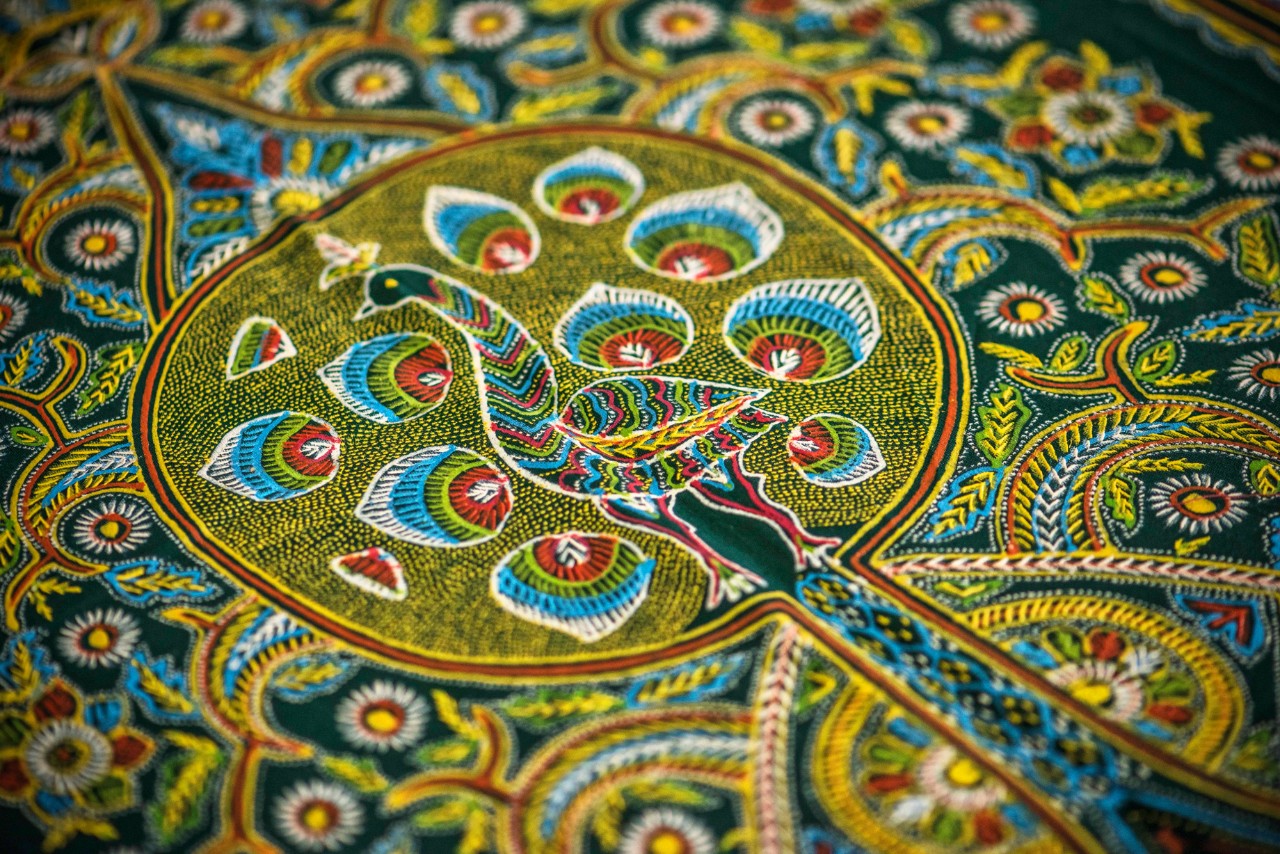
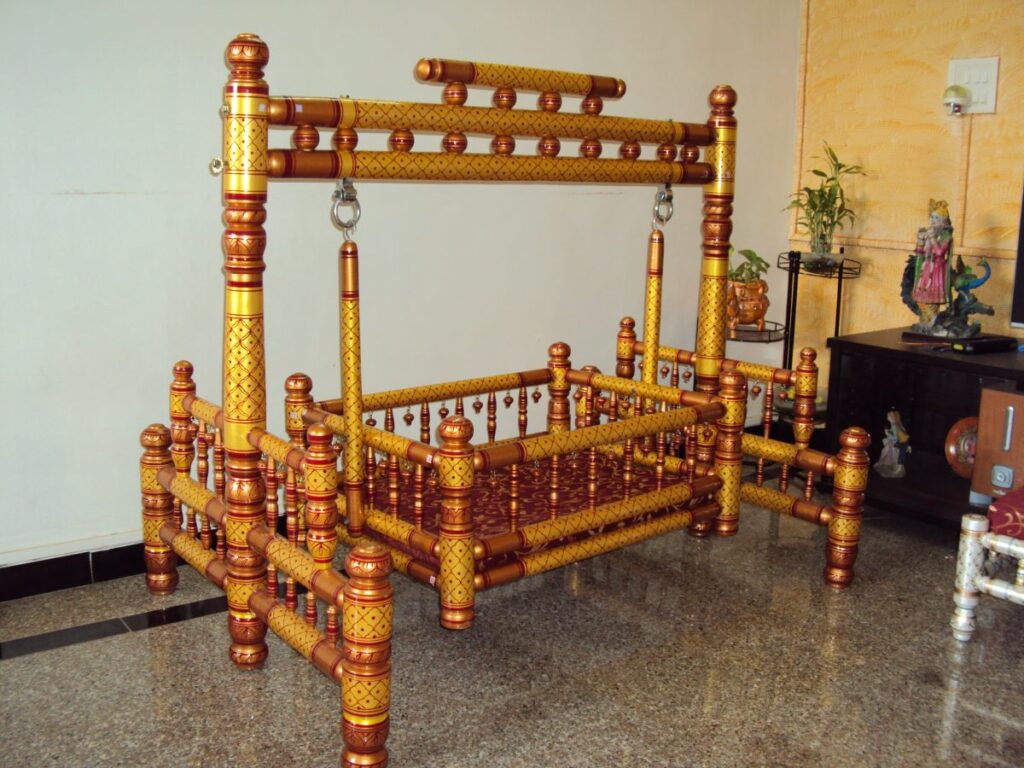
Sankheda Furniture (Sankheda)
Gujarat is no stranger to the labour of hammering, forging and casting that goes into producing pieces of metal. The state has been home to metal work for hundreds of years and today, you’ll find these stunning pieces in different corners of the world. These include statues, vases, utensils, ornaments, jewellery and furniture that boast of ornate designs. The Kutch specialty is silver jewellery renowned for its intricate handiwork. Besides silver, craftsmen use iron, copper and brass to cast some exquisite artefacts. The metal work reflects the finesse of artists who have spent years perfecting the craft.
A craft tradition so deeply inherent in the collective identity of the practitioners, that their town is named after it. Sankheda, a small town in the eastern region of Gujarat derives its name from ‘sanghedu’, the word for a lathe in the Gujarati language.
Lacquered turned wood furniture with hand painted motifs and traditional method of ornamentation, popularly known as Sankheda furniture, is thought to have been produced here from about 1855. In this town, about 80-100 families belonging to the “Kharadi-Suthar”community are involved in this craft, giving them a strong sense of community identity and continuity.
Every year, on the ‘Maha sud Teras’ day in February, the entire ‘Kahardi-Suthar‘ community, along with the ‘Sonis’ (jewellers), ‘Luhars’ (metal workers) and ‘Kumbhars’ (potters) comes together to worship lord‘Vishwakarma’ , the presiding Hindu deity of all craftsmen and architects, and celebrate and pray for the well-being of the community and the progress of their craft.
Single Ikat
Single Ikat is a style of interweaving tied and dyed warp with plain weft in a single textile form. Single Ikat sarees from the Rajkot region of Gujarat are much in demand for their simple elegance. The single ikat style of weaving is much simpler than the double ikat style, and hence sold at cheaper prices. This makes it a more affordable range of products. The single ikat style is commonly used to make sarees, kurtas, bedsheets and linen.
Single Ikat is a type of weaving technique where only the warp is resist-dyed, unlike double ikat where both the warp and weft are dyed. This traditional art form is still thriving in Gujarat, particularly in the city of Patan.
Characteristics of Single Ikat Weaving in Gujarat
- Only the warp is resist-dyed, making it a more labor-intensive process.
- Requires great skill and precision to produce intricate patterns.
- Typically used for creating prestigious cloths to be worn on auspicious days.
- Single Ikat is considered the premiere form of ikat weaving, requiring the most skill and labor.
Garvi Gurjari Handicrafts & Handloom Emporium
Garvi Gurjari is a government-run enterprise that markets handloom and handicraft products from Gujarat. They offer a range of Single Ikat products, including dupattas and other clothing items.
Buy Garvi Gurjari Single Ikat Products
You can purchase Garvi Gurjari Single Ikat products online from Amazon.in or other authorized retailers. These products are handmade by skilled artisans and weavers associated with the Gujarat Government.
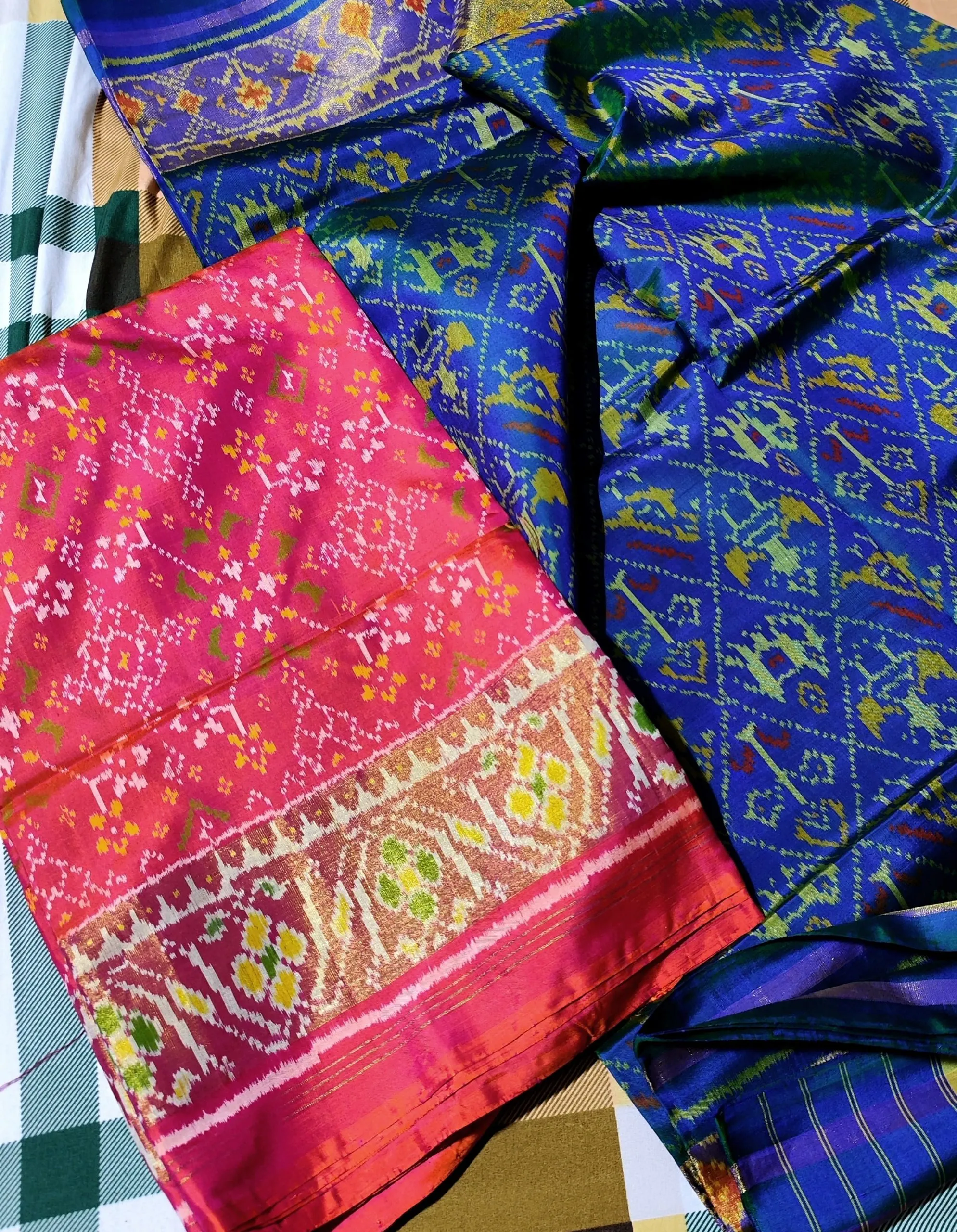
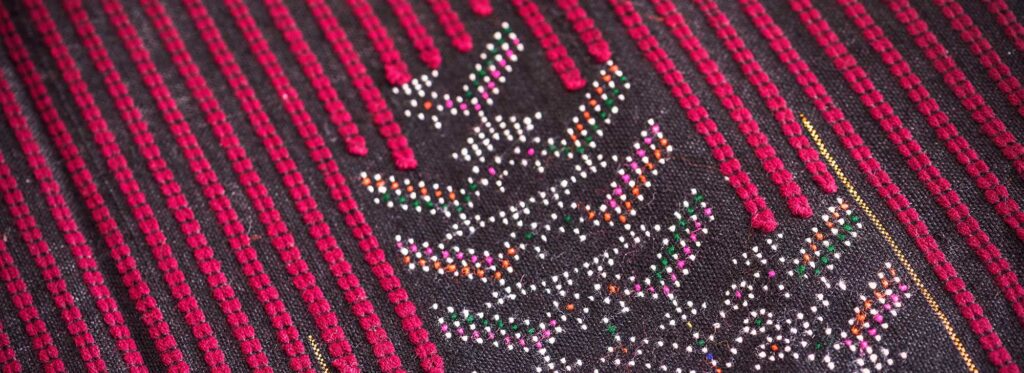
Tangaliya
This 700-year-old weaving craft is native to the Dangashiya community of Surendranagar, Gujarat. The community consists of weavers and shepherds. The weavers make the blankets out of sheep and goat wool for the shepherds to wear. The threads are woven to create the signature style of the weaving technique which is the effect of raised dots on the fabric. Together, they create beautiful geometrical patterns. Today, these textiles are used to make dupattas, dress material, bedsheets and pillow covers.
History and Origin
The exact details of the origin and evolution of Tangaliya craft are not available due to a lack of historical references. However, it is believed to have originated when a boy from a shepherd community married a girl from a weaver community and started weaving shawls using wool from his sheep.
Weaving Technique
Tangaliya weaving is a labor-intensive and time-consuming process. The contrasting colored threads are twisted into groups of 4-5 warps to create dana or beadwork. Geometric motifs are very sturdy for the rest of their lives, but give the impression of intricate weaving.
Products
Tangaliya is primarily used to create shawls, scarves, and other textiles. The shawls are made using yarns made from the wool of sheep in the Surendranagar district of Gujarat.
Pithora Painting
These wall murals are created as offerings to Pithora, the God of food grains. They are only painted by men commonly in the Chhotaudepur area of Gujarat. These simple paintings are traditionally done to seek blessings before a special occasion such as a wedding, the birth of a child or a festival. The paint is prepared by mixing pigments with milk and liquor prepared from the mahuda tree. Painters use a combination of bamboo sticks, cotton and wooden stencils to create their art. Although it is traditionally practiced only as wall art, today’s generation of pithora painters use paper and canvas that they sell commercially.
Pithora painting is a traditional folk art form of Gujarat, India, practiced by the Rathwa, Bhils, and Bhilala tribes. This ritualistic painting is done on walls, typically by men, as an offering to Pithora, the God of food grains.
History and Significance
Pithora paintings have a long history, dating back to cave paintings thousands of years old. The Rathwa community, who live in the region bordering Gujarat and Madhya Pradesh, have a deep social relevance attached to this art form. The paintings are characterized by the seven horses representing the seven hills that surround the area where the Rathwas reside.
Artistic Style
Pithora paintings are unique and have no two similar designs. The artists use a combination of bamboo sticks, cotton, and wooden stencils to create their art. The backgrounds are usually white or cream, but can be stark red for a rustic mud color appeal. The paintings have become fashionable in urban areas and are sold commercially on paper and canvas.
Traditional Practices
Traditionally, only men, called “Lakhindra,” are involved in painting. Unmarried girls can participate in plastering the background with dung, water, and chuna. The head priest, called “Bhadvo,” is a male shaman who is involved in the painting process.
Ritualistic Significance
Pithora paintings are created as offerings to Pithora, the God of food grains. They are typically painted before special occasions such as weddings, births, or festivals. The paintings are believed to bring peace, prosperity, and happiness to the family.
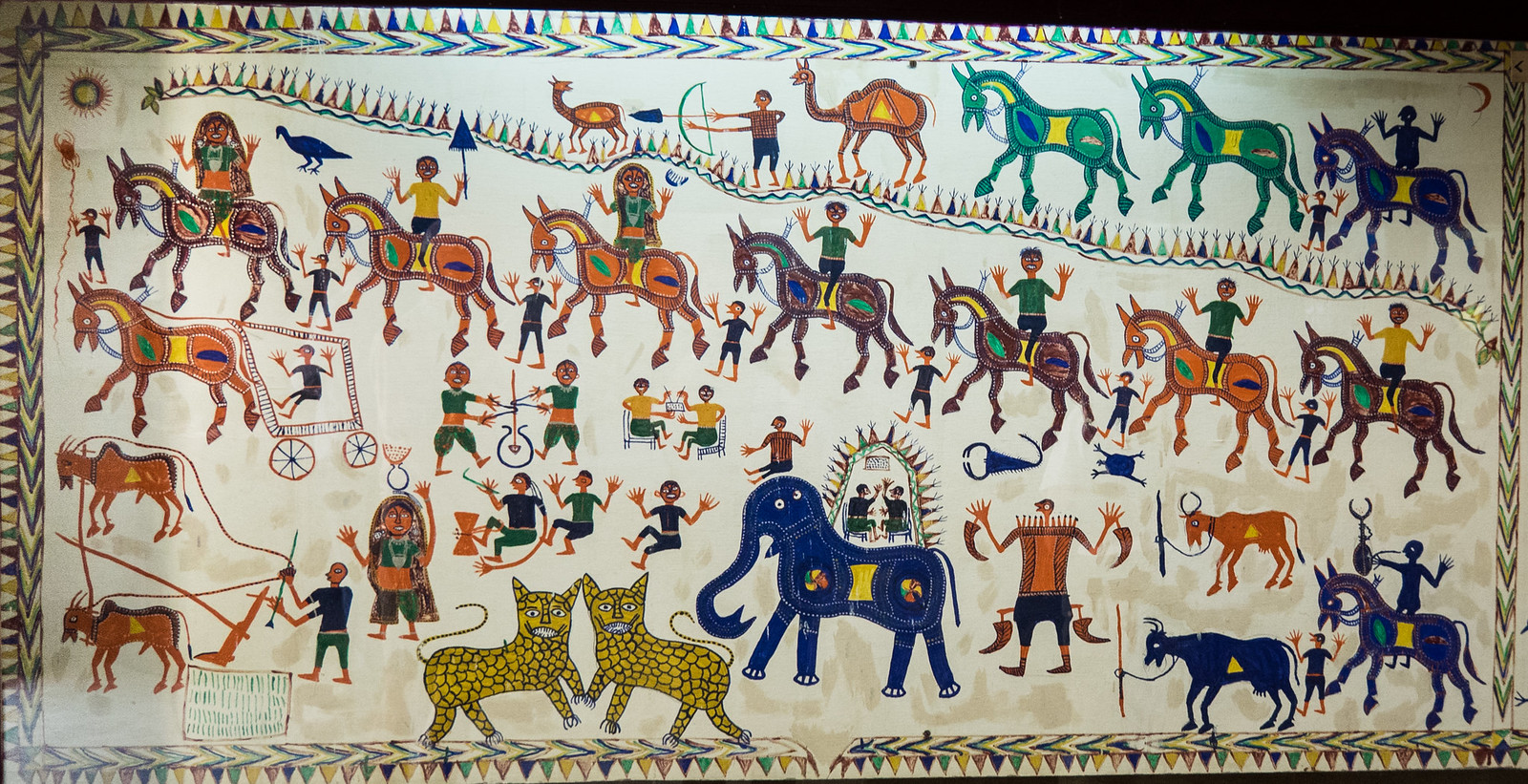

Bead Work
This simple craft is popularly practiced in Junagadh, a region most famous for its 19th century mausoleum ‘MahabatMaqbara’. It is also practiced in the Saurashtra region, Rajkot, Amreli and Ahmedabad. Gujarat can proudly be called the centre for bead craft in India. Local craftsmen make delicate household decorative items using beads as well as beautiful pieces of jewellery by string multicoloured beads together.
Pithora painting is a traditional folk art form of Gujarat, India, practiced by the Rathwa, Bhils, and Bhilala tribes. This ritualistic painting is done on walls, typically by men, as an offering to Pithora, the God of food grains.
History and Significance
Pithora paintings have a long history, dating back to cave paintings thousands of years old. The Rathwa community, who live in the region bordering Gujarat and Madhya Pradesh, have a deep social relevance attached to this art form. The paintings are characterized by the seven horses representing the seven hills that surround the area where the Rathwas reside.
Artistic Style
Pithora paintings are unique and have no two similar designs. The artists use a combination of bamboo sticks, cotton, and wooden stencils to create their art. The backgrounds are usually white or cream, but can be stark red for a rustic mud color appeal. The paintings have become fashionable in urban areas and are sold commercially on paper and canvas.
Traditional Practices
Traditionally, only men, called “Lakhindra,” are involved in painting. Unmarried girls can participate in plastering the background with dung, water, and chuna. The head priest, called “Bhadvo,” is a male shaman who is involved in the painting process.
Ritualistic Significance
Pithora paintings are created as offerings to Pithora, the God of food grains. They are typically painted before special occasions such as weddings, births, or festivals. The paintings are believed to bring peace, prosperity, and happiness to the family.
Ari Embroidery
This complex style of embroidery is commonly applied on silk fabric. Ari embroidery is highly stylised and artisans create delicate patterns that boast of their fine skill. It can even be said that each design spills out on fabric like a dreamy poem on paper. The fabric is usually held on a frame and the embroidery is done using a long needle with a hook at the end. You’ll find this on blouses, sarees and other garments and might include the addition of pearls, beads and sequins.
Ari embroidery of Gujarat is a traditional embroidery style that originated in the state of Gujarat, India. It is done using a hook-like needle called an “ari” on fabric stretched on a frame or “adda”. This style was earlier practiced by the Mochi community on leather, but later women of the house started practicing it on fabric.
Key Features
- The ari needle is used to create continuous fine chain stitches.
- The silk thread is fed from below, creating loops that lead to the line of chain stitches.
- The intricacy and use of beads add an added appeal to the embroidery.
- The fabric is usually held on a frame, and the embroidery is done using a long needle with a hook at the end.
History and Significance
Ari embroidery is a traditional craft that has been passed down through generations in Gujarat. It is known for its intricate designs and fine chain stitches, which are created using the ari needle. The embroidery is often used to adorn traditional clothing, such as saris and lehengas, and is a symbol of cultural heritage and tradition.
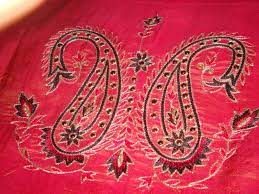

Applique Work
This is one of Gujarat’s oldest and finest crafts. The art form uses different patches of fabric in various colours and patterns that are placed together to create a multicoloured fabric much like a jigsaw puzzle. The work is used to create attractive, vibrant quilts, wall hangings, linen and clothing. The craft is popular in the Saurashtra, Banaskantha, Patan and Kutch regions of Gujarat.
Applique work is a traditional craft in Gujarat, India, that has been passed down through generations. The word “applique” comes from the French verb “appliquer,” meaning “to put on.” This ancient needlework practice involves stitching or bonding small pieces of fabric onto a larger fabric base to create intricate designs and patterns.
History of Applique Work in Gujarat
The history of applique work in Gujarat dates back to the times when women from native communities in north Gujarat produced large canopies, hangings, and friezes with human and animal figures stitched on them. The craft has evolved over time, with different regions in Gujarat developing their unique styles and techniques.
Types of Applique Work in Gujarat
There are several types of applique work in Gujarat, including:
- Patchwork: This involves sewing together small pieces of fabric to create a larger design or pattern.
- Applique: This involves stitching or bonding small pieces of fabric onto a larger fabric base to create intricate designs and patterns.
- Reverse Applique: This involves cutting out shapes from the surface fabric to create a design or pattern.
Designs and Patterns
Applique work in Gujarat is known for its vibrant colors and intricate designs. Traditional motifs include elephants, parrots, peacocks, flowers, and creepers. The designs and patterns used in applique work in Gujarat are often inspired by mythology and folklore.
Khadi
Khadi is a hand-woven natural fibre cloth that’s mainly made of cotton. The Surendranagar district of Gujarat has one of the largest handloom clusters in Gujarat where khadi can be bought in bulk at the bustling markets.The cloth is symbolic of India’s freedom movement and was introduced with the intention of people boycotting foreign goods during the national freedom movement. The material is known for its durability, comfort and ability to keep the wearer warm in winter and cool in summer.
Khadia is a location in Ahmedabad, Gujarat, India. It is situated in the state of Gujarat, which is known for its rich cultural heritage and textile industry. The official languages spoken in Khadia are Gujarati and Hindi, and the time zone is UTC+5:30 (IST). The PIN code is 380001, and the vehicle registration plate is GJ-1.
Gujarati Kadhi Gujarati kadhi is a popular dish from Gujarat, made with gram flour, spices, herbs, and seasonings. It is a sweet and tangy yogurt-based dish that can be served with steamed basmati rice or roti. This easy recipe is a quick and comforting option for lunch or dinner.
Khadi Khadi is a hand-woven natural fiber cloth made mainly from cotton. It is a symbol of India’s freedom movement and was introduced to promote self-sufficiency during the national freedom movement. Khadi is sometimes starched to give it a stiffer feel and is widely accepted in various fashion circles.
Khadi Gujarat Khadi is a significant part of Gujarat’s textile industry, with the Surendranagar district having one of the largest handloom clusters in the state. The cloth is made from cotton, silk, or wool, which are all spun into yarn on a charkha. It is a versatile fabric that remains cool in summer and warm in winter.
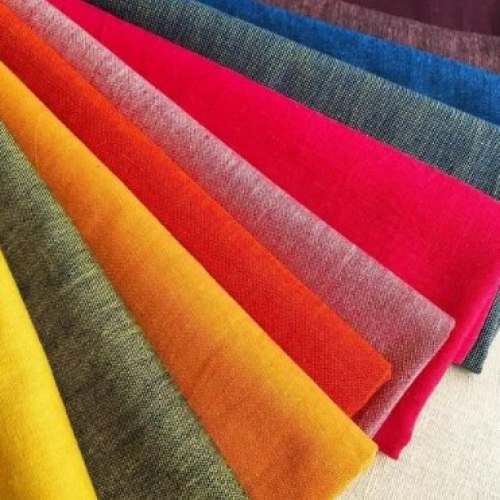
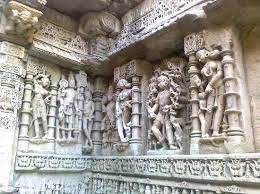
Stone Carving (Sompura)
The indigenous community of Meghwals are prime producers of leather work in the Kutch district of Gujarat. This is one of those timeless crafts which has grown to combine traditional methods of design with modern functionalities. Its production is a combined effort between men and women. The men fashion the product from the leather while the women embellish it with mirrors and bead work. Originally, the craft was used to make saddles for elephants and horses, sword sheaths and accessories for war. Today, it is used to make beautiful bags and shoes with colourful tassels and embellishments.
Sompura Stone Handicraft is a skilled team of artisans who have been involved in stone carving for generations. They offer a range of services, including temple architecture and contracting, and are known for their attention to detail and commitment to quality.
Focus
Their focus is on creating intricate and beautiful stone carvings, using traditional techniques passed down through generations. They work with a variety of stones, including marble, granite, and sandstone, to create unique and stunning pieces.
Expertise
With years of experience in the field, Sompura Stone Handicraft has developed a reputation for their expertise in stone carving. They have worked on numerous projects, including temples, monuments, and other structures, and have a deep understanding of the art of stone carving.
Summary
Sompura Stone Handicraft is a skilled team of artisans who specialize in stone carving works, including temple architecture and contracting. They offer a range of services, including all types of stone carving, and are known for their attention to detail and commitment to quality.
Silver Ornaments
In Gujarat, the most common forms of jewellery are made from agate, silver and beads. Silver is used to fashion earrings, nose rings, bangles and necklaces that are sold across the state. Silver bars are converted into sheets and wires which are molded into various ornaments and jewellery. Silver ornaments are popular presents for people of all ages and from heavy jewellery they have now begun to craft light, delicate creations that make beautiful earrings, wall hangings, bangles and chains.
Silver ornaments are decorative items made from silver, a precious metal, and are often used to add a touch of elegance and sophistication to various settings, such as homes, offices, or special occasions. Here are some key details about silver ornaments:
- Types of Silver Ornaments: Silver ornaments come in various forms, including pendants, earrings, rings, necklaces, and other decorative items.
- Materials: Silver ornaments can be made from pure silver, sterling silver, or rhodium-plated silver, each with its own unique characteristics and benefits.
- Designs and Styles: Silver ornaments are available in a wide range of designs and styles, from classic and traditional to modern and contemporary.
- Uses: Silver ornaments can be used as jewelry, decorative items, or as gifts for special occasions.
- Quality and Durability: High-quality silver ornaments are known for their durability and resistance to tarnish, ensuring they remain beautiful and intact for a long time.
Notable Brands and Products
- AR Silver Ornaments: A sub-brand of AR Group, known for their passion for jewelry and attention to detail.
- Amazon Silver Ornaments: Amazon offers a wide range of silver ornaments from various brands, including exclusive products and competitive pricing.
Key Features and Benefits
- Unique Designs: Silver ornaments come in unique and exclusive designs, making them perfect for special occasions or as a statement piece.
- Durable and Long-Lasting: High-quality silver ornaments are resistant to tarnish and can last for a long time with proper care.
- Versatile: Silver ornaments can be used as jewelry, decorative items, or as gifts for special occasions.
- Affordable: Silver ornaments are available at various price points, making them accessible to a wide range of customers.
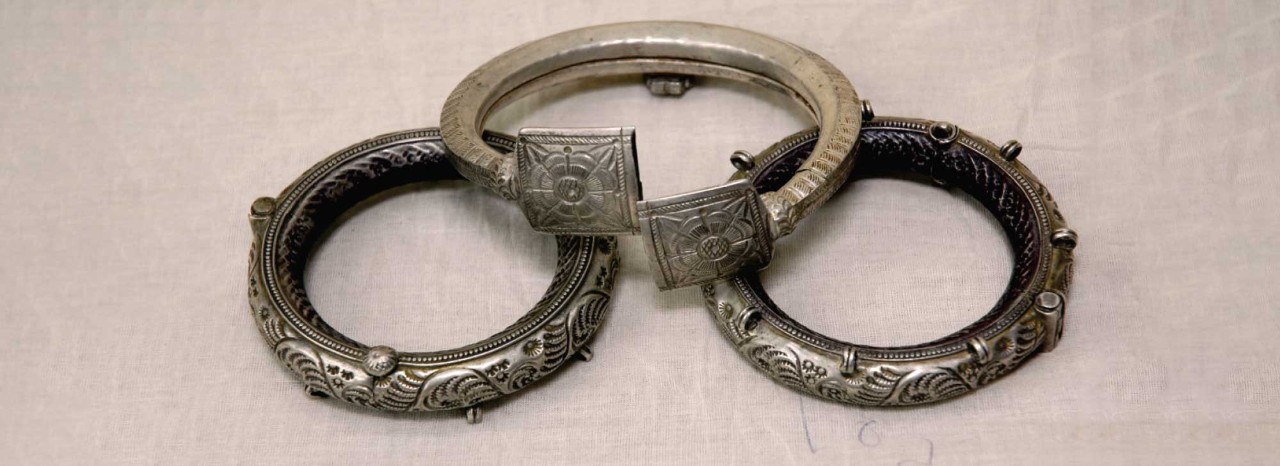
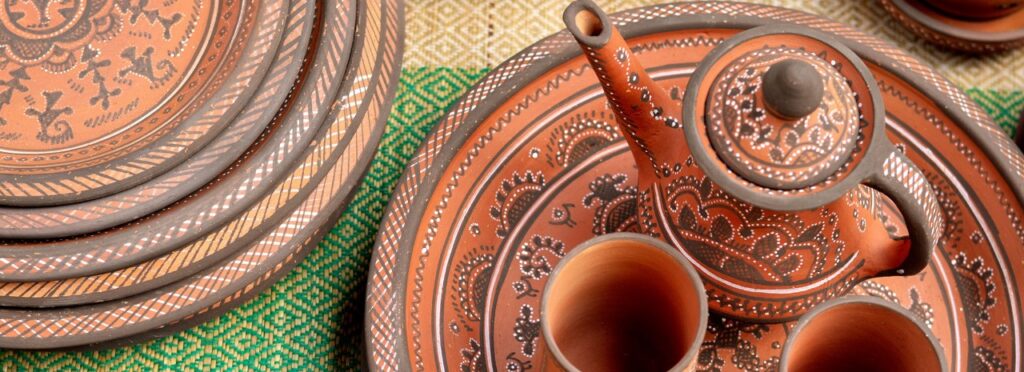
Terracotta
In the Sabarkantha district of Gujarat, in the town of Poshina, is where you will see the finest display of terracotta work in Gujarat. Thousands of terracotta horses stand in rows in a tribal shrine in Poshina, as offerings to the local Goddess. Nearby, the surrounding villages have similar carved horses. The local people offer these figures to their deity and pray for good health, prosperity and luck. The tribes folk of the villages pride themselves in their delicate creations.
Gujarat is one of the prominent production centers of terracotta art in India. The state is known for its rich cultural heritage and traditional crafts, including terracotta products. Here are some details about terracotta art in Gujarat:
- Hand-painted clay and terracotta products: Gujarat is famous for its hand-painted clay and terracotta products, which are produced using traditional techniques and methods.
- Intricate designs and statues: The tribes of Gujarat, such as the Bhils and the Kolis, are skilled craftsmen who create intricate designs and statues of animals and birds using terracotta.
- Traditional techniques: The artisans of Gujarat use traditional techniques to create terracotta products, including hand-building, wheel-throwing, and slip-casting.
- Variety of products: Terracotta products in Gujarat include decorative items, such as figurines, vases, and sculptures, as well as functional items, such as water and waste water pipes, tableware, and roofing tiles.
Some notable examples of terracotta art in Gujarat include:
- Bhagyashree Kulhad Art: A renowned artisan from Ahmedabad, Bhagyashree Kulhad Art creates beautiful clay tea cups, terracotta pots, and sambrani cups using traditional techniques.
- Prajapati Clay Art: A manufacturer from Rajkot, Prajapati Clay Art produces a range of terracotta products, including bird baths, chapati boxes, and water pots.
Patola
Gujarat is known for its world famous double ikat patola from patan. It is a colourful and ostentatious weave with its figured body, along with the subtle merging of one shade into another. It is generally worn on auspicious and important occasions. The magic of patola textile is created by the art of lying and dyeing both the warp and west silk threads and then weaving them with great skill and precision into priceless fabric forms with clear and crisp patterns.
Patola is a traditional double ikat woven sari from Gujarat, India. It is known for its intricate and colorful designs, created by the art of lying and dyeing both the warp and weft silk threads before weaving them into fabric.
Key Features:
- Double ikat weaving technique: Both the warp and weft threads are dyed separately before weaving, creating intricate patterns.
- Colorful and ostentatious designs: Patola saris are known for their vibrant colors and intricate designs, often featuring geometric patterns and floral motifs.
- Expensive and exclusive: Patola saris are highly prized and expensive, historically worn only by royal and aristocratic families.
- Made from cultivated silk: The raw material used for weaving Patola saris is cultivated silk.
- Woven in specific regions: Patola saris are primarily woven in the Patan region of Gujarat, with some villages in Surendranagar and Rajkot districts also producing single ikat Patola.
Artistic Significance:
- Unique weaving technique: The double ikat technique used in Patola weaving is rare and requires great skill and precision.
- Cultural significance: Patola saris are an important part of Gujarati culture and are often worn on auspicious and important occasions.
- Artistic expression: The intricate designs and patterns created through the Patola weaving technique are a testament to the artistic skill and creativity of the weavers.
